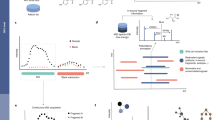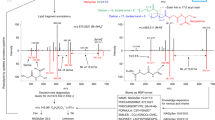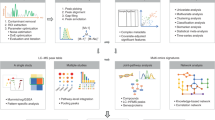Abstract
Data-independent acquisition (DIA) in liquid chromatography (LC) coupled to tandem mass spectrometry (MS/MS) provides comprehensive untargeted acquisition of molecular data. We provide an open-source software pipeline, which we call MS-DIAL, for DIA-based identification and quantification of small molecules by mass spectral deconvolution. For a reversed-phase LC-MS/MS analysis of nine algal strains, MS-DIAL using an enriched LipidBlast library identified 1,023 lipid compounds, highlighting the chemotaxonomic relationships between the algal strains.
This is a preview of subscription content, access via your institution
Access options
Subscribe to this journal
Receive 12 print issues and online access
$259.00 per year
only $21.58 per issue
Buy this article
- Purchase on Springer Link
- Instant access to full article PDF
Prices may be subject to local taxes which are calculated during checkout



Similar content being viewed by others
References
Zhu, X., Chen, Y. & Subramanian, R. Anal. Chem. 86, 1202–1209 (2014).
Röst, H.L. et al. Nat. Biotechnol. 32, 219–223 (2014).
Reiter, L. et al. Nat. Methods 8, 430–435 (2011).
Tsugawa, H. et al. Anal. Chem. 85, 5191–5199 (2013).
Nikolskiy, I. et al. Anal. Chem. 85, 7713–7719 (2013).
Stein, S.E. J. Am. Soc. Mass Spectrom. 10, 770–781 (1999).
Fiehn, O., Wohlgemuth, G. & Scholz, M. Proc. Lect. Notes Bioinform 3615, 224–239 (2005).
Tsugawa, H., Kanazawa, M., Ogiwara, A. & Arita, M. Bioinformatics 30, 2379–2380 (2014).
Horai, H. et al. J. Mass Spectrom. 45, 703–714 (2010).
Kind, T. et al. Nat. Methods 10, 755–758 (2013).
Wold, S., Sjostrom, M. & Eriksson, L. Chemometr. Chemometr. Intell. Lab. 58, 109–130 (2001).
Yap, C.W. J. Comput. Chem. 32, 1466–1474 (2011).
Gladu, P.K., Patterson, G.W., Wikfors, G.H. & Smith, B.C. J. Phycol. 31, 774–777 (1995).
Kind, T. et al. J. Chromatogr. A 1244, 139–147 (2012).
Haigh, W.G. et al. Biochim. Biophys. Acta 1299, 183–190 (1996).
Giroud, C., Gerber, A. & Eichenberger, W. Plant Cell Physiol. 29, 587–595 (1988).
Schymanski, E.L. & Neumann, S. Metabolites 3, 412–439 (2013).
Sumner, L.W. et al. Metabolomics 3, 211–221 (2007).
Creek, D.J. et al. Metabolomics 10, 350–353 (2014).
Egertson, J.D. et al. Nat. Methods 10, 744–746 (2013).
Savitzky, A. & Golay, M.J.E. Anal. Chem. 36, 1627–1639 (1964).
Lommen, A. Anal. Chem. 81, 3079–3086 (2009).
Windig, W., Phalp, J.M. & Payne, A.W. Anal. Chem. 68, 3602–3606 (1996).
Hiller, K. et al. Anal. Chem. 81, 3429–3439 (2009).
Katajamaa, M., Miettinen, J. & Oresic, M. Bioinformatics 22, 634–636 (2006).
Sud, M. et al. Nucleic Acids Res. 35, D527–D532 (2006).
Cavalier-Smith, T. Biol. Rev. Camb. Philos. Soc. 73, 203–266 (1998).
Wang, Z. et al. Nature 472, 57–63 (2011).
Lee, Y., Park, J.-J., Barupal, D.K. & Fiehn, O. Mol. Cell. Proteomics 11, 973–988 (2012).
Higgins, B.T. & VanderGheynst, J. PLoS ONE 9, e96807 (2014).
Tanadul, O.U., Vandergheynst, J.S., Beckles, D.M., Powell, A.L. & Labavitch, J.M. Biotechnol. Bioeng. 111, 1323–1331 (2014).
Brand, J.J., Andersen, R.A. & Nobles, D.R. Jr. in Applied Phycology and Biotechnology Second Edition, John Wiley & Sons, Ltd, Oxford, UK 10.1002/9781118567166.ch5 (2013).
Matyash, V., Liebisch, G., Kurzchalia, T.V., Shevchenko, A. & Schwudke, D. J. Lipid Res. 49, 1137–1146 (2008).
Acknowledgements
This work was supported by the US National Science Foundation (NSF)–Japan Science and Technology Agency (JST) Strategic International Collaborative Research Program (SICORP) for Japan–United States metabolomics. We also thank the Lipid MAPS consortium for providing us the lipid SDF files; ChemAxon for a free research license for the Marvin and JChem cheminformatics tools; Z. Tietel and N. Nguyen (UC Davis) for assisting with the sample preparation of algal species; T. Bamba, Y. Izumi and T. Yamada (Osaka University) for suggestions and discussion of lipid annotation; D. Yukihira (Kyushu University) for discussion of retention time prediction; and A. Ogiwara (Reyfics Inc.) for development of the ABF file and for suggestions and discussion about MS-DIAL development. H.T. was also supported by Grant-in-Aid for Young Scientists (B) (Japan) 25871136. This study was also supported by the NSF (NSF MCB 113944), National Institutes of Health (NIH) (Grants P20 HL113452 and U24 DK097154), the JST-Core Research for Evolutionary Science and Technology (JST-CREST), and Database Integration Coordination Program by the National Bioscience Database Center (Japan).
Author information
Authors and Affiliations
Contributions
H.T., O.F. and M.A. designed the research. H.T. developed the MS-DIAL program. H.T. and T.C. analyzed the samples. T.C. and Y.M. contributed to the improvement of MS-DIAL program. H.T., T.K. and Y.M. performed the lipid annotations for the retention time prediction. H.T., T.K. and K.I. improved and optimized the LipidBlast library. H.T., B.H. and J.V. prepared the algal samples. M.K. developed the ABF file and the converter for this project. H.T., O.F. and M.A. thoroughly discussed this project and wrote the manuscript. T.C., T.K., B.H. and J.V. also contributed to the manuscript.
Corresponding authors
Ethics declarations
Competing interests
Mitsuhiro Kanazawa is Representive Director and a developer in Reifycs Inc., which provides the ABF converter of mass spectral data for free at http://www.reifycs.com/english/AbfConverter/.
Supplementary information
Supplementary Text and Figures
Supplementary Figures 1–10, Supplementary Tables 1–4 and Supplementary Note (PDF 31983 kb)
Supplementary Data 1
Tables for the retention time prediction of lipid compounds. Excel sheet of 'Molecular descriptors (MDs)' includes 464 molecular descriptors of 254 lipid compounds calculated by the PaDEL-descriptor program. Excel sheet of 'Scaled Table of MDs' includes the auto-scaled data for partial least square (PLS) regression. The auto-scaling method uses mean-centering followed by the division by the standard deviation of each column. Excel sheets of 'Scores of PLS-R', 'Loadings of PLS-R', and 'Summary of PLS regression' include the scores, loadings, and the summary of PLS regression model, respectively. (XLSX 1639 kb)
Supplementary Data 2
Table of lipid descriptors for chemotaxonomy. The presence or absence in each of nine species is represented as a binary data matrix of size 1023 x 9. The lipid name, formula, retention time, isotope ratio, precursor m/z, and MS/MS spectrum are also included with their theoretical values or similarity scores. (XLSX 860 kb)
Supplementary Data 3
Tables of raw data matrix from total 31 LC-MS/MS experiments. The row and column include lipid names and algal names with their replicate numbers, respectively. The peak height is used as the quantification value of each lipid compound. The zero value indicates 'not detected'. The two excel sheets include the results of data-independent (SWATH) and the traditional data-dependent (DDA) methods, respectively. (XLSX 272 kb)
Supplementary Data 4
Table for the explanation of MS/MS deconvolution. The workflow of deconvolution is described with the simulation data. (XLSX 35 kb)
Supplementary Software
MS-DIAL software (ZIP 7095 kb)
Source data
Rights and permissions
About this article
Cite this article
Tsugawa, H., Cajka, T., Kind, T. et al. MS-DIAL: data-independent MS/MS deconvolution for comprehensive metabolome analysis. Nat Methods 12, 523–526 (2015). https://doi.org/10.1038/nmeth.3393
Received:
Accepted:
Published:
Issue Date:
DOI: https://doi.org/10.1038/nmeth.3393
This article is cited by
-
Novel insight into the lipid network of plasma extracellular vesicles reveal sex-based differences in the lipidomic profile of alcohol use disorder patients
Biology of Sex Differences (2024)
-
Resource competition predicts assembly of gut bacterial communities in vitro
Nature Microbiology (2024)
-
Comprehensive plasma steroidomics reveals subtle alterations of systemic steroid profile in patients at different stages of prostate cancer disease
Scientific Reports (2024)
-
In vivo neuroprotective capacity of a Dunaliella salina extract - comprehensive transcriptomics and metabolomics study
npj Science of Food (2024)
-
Leukemia inhibitory factor suppresses hepatic de novo lipogenesis and induces cachexia in mice
Nature Communications (2024)



